Building a masterful perfume blend requires understanding the three-tier fragrance pyramid. You'll want to start with bright top notes like citrus and aromatics (20-40%), which create initial impact but fade quickly. Then layer in your middle notes of florals and spices (50-75%) for the heart of your scent. Finally, add lasting base notes like vanilla or musk (15-25%) for depth. Master these ratios, and you'll reveal the secrets to creating signature fragrances.
Understanding the Three-Tier Fragrance Pyramid
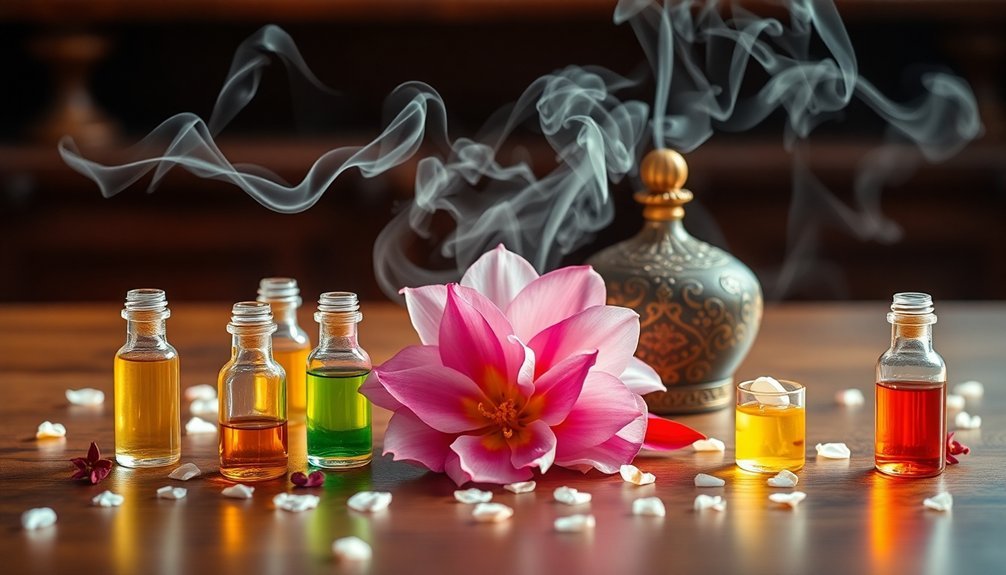
When you first explore the art of perfumery, you'll encounter the fragrance pyramid – a fundamental concept that illustrates how scents evolve over time.
This three-tiered structure reveals how your perfume will develop from the initial spritz to its final lingering notes. Testing on skin is essential for experiencing how the fragrance interacts with your unique body chemistry.
The pyramid begins with volatile top notes that last up to two hours, featuring fresh scents like citrus and mint.
Moving to the heart, you'll find the fragrance's true character emerging within ten minutes, expressed through florals, fruits, and spices that can persist for three hours.
Finally, the base notes appear after 30 minutes, providing rich depth through ingredients like vanilla, woods, and musk.
These lasting elements can remain on your skin for hours and on clothing for days, creating the fragrance's enduring signature.
Essential Components of Top Notes
Top notes bring your fragrance to life with bright citrus elements like bergamot and lemon, creating an immediate, energetic impact that'll capture attention.
You'll find these notes working alongside fresh aromatics such as lavender and rosemary to establish the perfume's initial character.
These volatile components start evaporating within minutes of application, making way for the deeper, more enduring notes to emerge.
These initial scents typically last 5 to 15 minutes before fading into the middle notes.
Citrus Notes and Impact
Citrus notes bring an unmistakable burst of freshness to perfume compositions, serving as essential top notes that create immediate impact. You'll find these zesty elements derived from fruits like bergamot, lemon, and grapefruit, with their oils extracted primarily from the peels.
When you're selecting a fragrance with citrus top notes, you're choosing more than just a scent. These notes deliver therapeutic benefits, helping to uplift your mood and reduce anxiety while enhancing focus.
They're particularly effective in spring and summer fragrances, though you'll also find them skillfully incorporated into winter blends, especially in chypre perfumes and festive scents. Luxury citrus perfumes have demonstrated remarkable staying power and sillage compared to casual fragrances.
The key to their success lies in how they're balanced with other fragrance families – they'll harmonize beautifully with florals, woods, and amber notes when properly composed.
Fresh Aromatic Combinations
Fresh aromatic combinations create the first impression of a fragrance through an intricate blend of green, leafy, and ozonic elements.
You'll find these top notes incorporate cooling mint, camphoraceous scents, and herbal components like basil and anise to establish an inviting opening.
When crafting fresh aromatics, you can blend light florals such as lavender and rose with crisp green nuances.
The addition of coastal-inspired elements like wet dew or sea breeze adds depth without relying on citrus.
Popular examples include Australian Coast's ozonic-lemon fusion and Cool Mountain Mist's intense green profile.
These fresh combinations don't just set the tone—they're essential for smoothly progressing into the heart notes while maintaining the fragrance's bright, uplifting character.
You'll notice how they work together to create a memorable introduction that enhances the overall perfume composition.
Quick Evaporation Properties
Building upon the fresh aromatic combinations, understanding evaporation properties reveals why certain scents fade so quickly.
You'll notice that top notes, which create your first impression of a fragrance, typically evaporate within 5-15 minutes, though some may last up to 30 minutes.
These volatile components, including citrus oils, marine notes, and fresh florals, dissipate rapidly due to their lightweight molecular structure.
If you're applying perfume in warm weather or on pulse points, you'll experience even faster evaporation.
While this quick fade might seem disappointing, it's actually essential to the perfume's development, as these fleeting notes make way for the heart of the fragrance.
You'll find that natural top notes offer a more dynamic evolution compared to synthetic ones, creating a more sophisticated olfactory experience.
The Art of Middle Note Selection
When you're selecting middle notes for your perfume blend, you'll find that floral ingredients like jasmine and rose work harmoniously with both fruity top notes and deeper base notes.
To create a more complex fragrance profile, you can pair spicy elements like cardamom and cinnamon with herbal components such as basil and thyme.
These combinations offer endless possibilities for crafting unique scent signatures while maintaining the balanced structure essential to any well-composed fragrance.
Floral Harmony in Perfumery
The delicate art of floral harmony in perfumery centers on middle notes, which form 50-75% of a fragrance's composition and define its essential character.
You'll find classic middle notes like lavender, rose, geranium, and jasmine creating a warm, full-bodied presence that lasts 20-60 minutes on your skin.
When you're exploring floral harmony, you'll notice how middle notes seamlessly bridge top and base notes through carefully balanced compounds like linalool.
These notes don't just provide depth; they're vital in crafting memorable scent experiences.
You can discover innovative blends that combine traditional flowers with contemporary elements like osmanthus and CO2-extracted black tea.
Through various extraction methods, perfumers create stable, consistent aromas that evolve beautifully over time, ensuring your fragrance tells a compelling olfactory story.
Spice and Herbal Pairings
Mastering spice and herbal pairings in middle notes requires understanding how these aromatic elements create depth and complexity in your fragrance. You'll find that spices like cinnamon and cardamom add warmth, while herbs like rosemary and basil bring earthiness and refreshment. When you're blending these notes, remember they typically comprise 50-75% of your fragrance composition.
| Spice Note | Herbal Note | Perfect Pairing Effect |
|---|---|---|
| Cinnamon | Rosemary | Warm-woody balance |
| Cardamom | Basil | Sweet-fresh contrast |
| Black Pepper | Thyme | Spicy-herbal depth |
| Ginger | Lemongrass | Zesty-aromatic blend |
You can create unique combinations by experimenting with different ratios and intensities. These middle notes work harmoniously with florals and help progress smoothly from top notes to base notes, ensuring your fragrance remains balanced and long-lasting.
Base Notes: Building a Strong Foundation
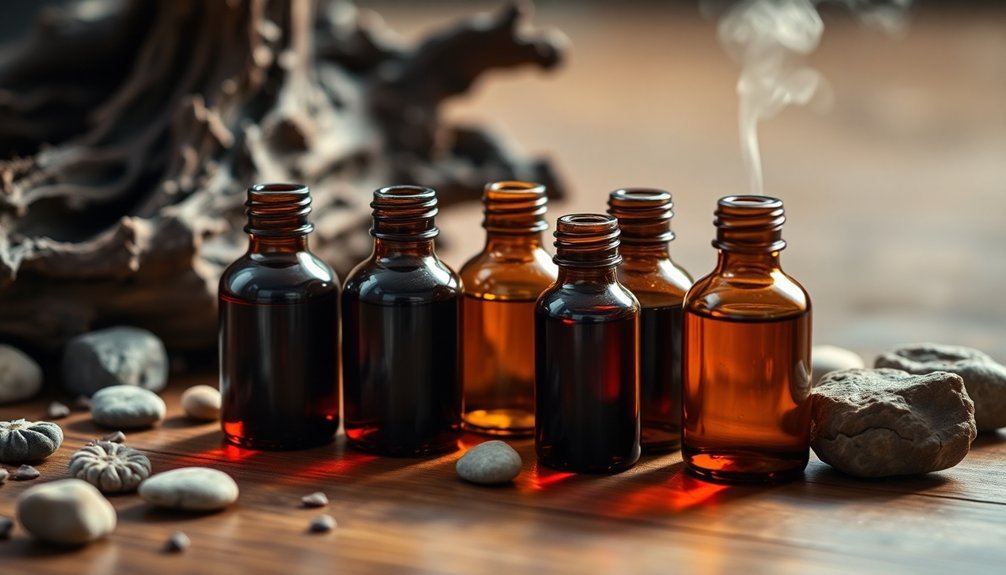
Understanding base notes is vital for creating lasting, sophisticated perfumes. These rich, heavy notes form your fragrance's foundation and kick in after about 30 minutes, lasting six hours or more on your skin.
You'll find common base notes like vanilla, amber, musk, and woody elements such as sandalwood and cedarwood. Oriental notes like myrrh and oud add unique character, while earthy options like vetiver and tonka bean provide depth.
When you're building your fragrance pyramid, these base notes will determine your perfume's lasting impression and work harmoniously with heart notes to create the final scent.
Base notes don't just add character; they're important fixatives that help your entire fragrance last longer. They interact with your body chemistry and guarantee your perfume leaves a memorable impression long after application.
Perfect Ratios for Lasting Scents
Creating lasting perfumes starts with understanding the essential ratios between your top, middle, and base notes.
You'll want to aim for 20-40% top notes to create that initial impression, followed by 50-75% middle notes that form the heart of your fragrance.
While traditional formulas suggest ratios like 3:2:1 or 4:2:1, you can adjust these proportions based on your desired scent profile and creative vision.
Balanced Note Distribution Guide
To achieve a perfectly balanced fragrance that evolves gracefully throughout the day, you'll need to follow specific ratios when blending your perfume notes.
Start with 15-25% top notes, which provide that initial burst of freshness through citrus or light floral scents. These will fade within the first half hour, making way for your middle notes.
Allocate 30-40% to middle notes, the heart of your fragrance, using florals like jasmine or rose. These notes create the signature character of your blend.
Reserve 40-50% for your base notes, incorporating deeper scents like vanilla, musk, or sandalwood. This higher proportion of base notes guarantees your fragrance maintains its staying power and depth throughout the day, while still allowing the lighter notes to shine through.
Essential Proportions For Success
When crafting a lasting perfume blend, the proven 30-50-20 rule serves as your foundation for success.
Start with 30% top notes for immediate impact, follow with 50% middle notes to maintain presence, and anchor with 20% base notes for longevity.
You'll find this ratio adaptable to any quantity – for a 50-drop blend, simply use 15-25-10 drops respectively.
To enhance your blend's effectiveness, apply the Four Classifications System.
Begin with your personifier at 50-80% of the mixture, then add enhancers to boost aromatic qualities.
Follow with equalizers at 5-8% for balance, and finish with modifiers to perfect the scent.
Remember to take into account aroma strength when selecting oils – powerful scents like peppermint require fewer drops than gentler ones like lavender, typically using a 1:4-8 ratio.
Blending Techniques for Beginners
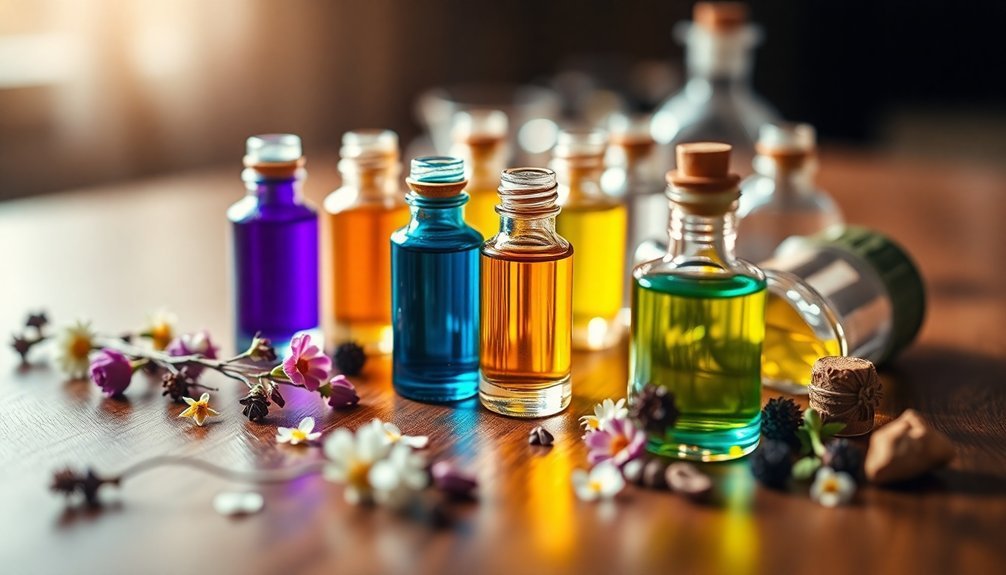
Making your own perfume blends starts with understanding the fundamental techniques that form the backbone of fragrance creation.
You'll want to choose between three proven approaches: layered blending, drop-by-drop, or incremental blending, depending on your comfort level and desired precision.
When you're ready to begin, remember these essential steps:
- Always wear protective gear like gloves and goggles to prevent skin or eye irritation.
- Start with small amounts, typically using the 30-50-20 ratio of base, middle, and top notes.
- Let your blend mature for several days to allow the oils to interact and develop their full character.
Record each combination in a notebook as you work, noting the exact measurements and your observations.
This documentation will help you refine future blends and develop your signature scents.
Common Mistakes to Avoid When Mixing Notes
Even experienced perfumers can fall prey to common blending mistakes that compromise their fragrances. You'll want to avoid incorrect ratios, sequential mixing errors, and timing issues that can ruin your blend.
| Mistake | Solution |
|---|---|
| Wrong note ratios | Follow 3:2:1 or 4:2:1 (top:middle:base) guidelines |
| Improper mixing order | Add base notes first, then middle, then top |
| Overapplication | Use minimal amounts, let fragrance develop |
| Poor timing | Wait 10-15 minutes before going out |
| Family clashes | Study complementary fragrance families |
Don't mix without understanding fragrance families or their interactions. You'll need to record your steps and measurements for future replication. Remember that natural perfumes evolve differently than synthetic ones, so give your blend time to settle between adding layers.
Tools and Equipment for Note Blending
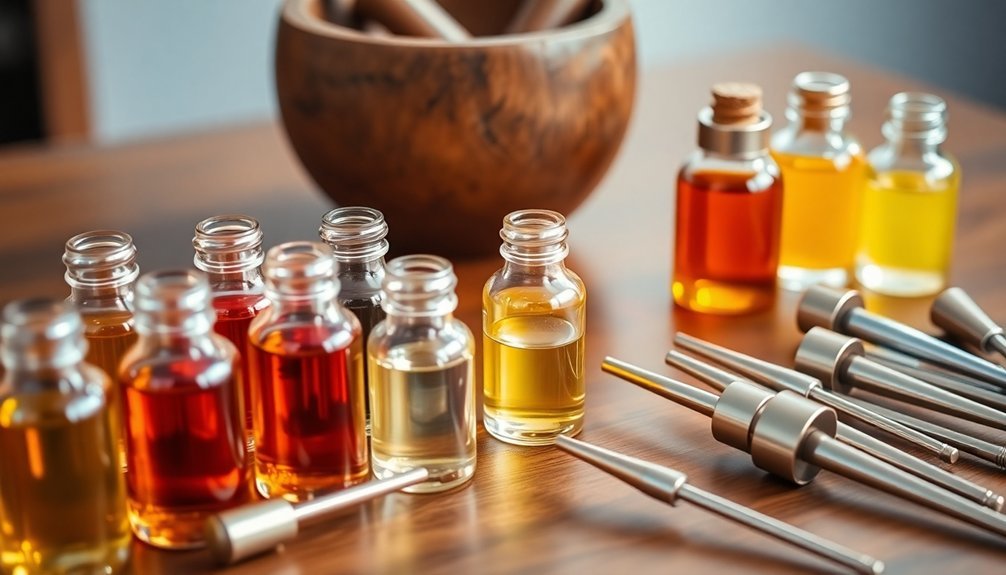
Professional perfume blending requires specific tools and equipment to confirm precision and safety.
You'll need accurate measuring instruments like digital scales and pipettes, along with proper mixing equipment such as glass beakers and stirring rods.
Don't forget essential safety gear including gloves, masks, and protective eyewear to prevent exposure to concentrated fragrances.
To create successful perfume blends, you'll want to focus on these key equipment categories:
- Precision tools – Digital scales and pipettes confirm exact measurements down to 0.01g
- Testing materials – Fragrance blotters and aerosol testers help evaluate scent development
- Storage solutions – Properly labeled bottles and containers maintain blend integrity
Keep your workspace organized with labeled containers and protective covers to prevent cross-contamination and surface damage during your blending process.
Natural Vs Synthetic Note Combinations
With your tools and workspace properly set up, you'll need to contemplate whether to use natural or synthetic ingredients in your perfume blends.
Natural ingredients, derived from plants and animals, offer authentic, complex scents with potential therapeutic benefits. While they're gentler on your skin and environmentally friendly, they can vary in scent due to natural conditions.
Synthetic ingredients, created in laboratories, provide consistent scents and better longevity at a lower cost. You'll find they're more versatile, allowing you to create unique fragrances or replicate scents that don't exist in nature. However, they may cause sensitivity in some users.
Your choice will depend on your priorities: if you value authenticity and therapeutic properties, go natural; if you need consistency and cost-effectiveness, synthetic ingredients might be your better option.
Creating Signature Scent Profiles

Creating your signature scent profile requires a thorough understanding of fragrance architecture and how different notes interact over time. You'll want to build your fragrance from the bottom up, starting with enduring base notes like sandalwood or patchouli to establish a strong foundation.
When crafting your unique blend, follow these essential steps:
- Select harmonious heart notes that complement your chosen base, focusing on florals or spices that align with your desired scent profile.
- Add fresh top notes like citrus or herbs to create an inviting first impression.
- Test different combinations while adhering to IFRA safety guidelines for proper dilution rates.
Remember to embrace experimentation, as finding the perfect balance often requires multiple trials. Your signature scent should evolve naturally, revealing different facets throughout its wear time.
Testing and Adjusting Your Blends
Once you've created your initial blend, thorough testing becomes essential for achieving a perfectly balanced fragrance. Start by using smelling strips to evaluate your creation, then explore different testing methods like wax melts or room sprays to understand how your blend performs in various mediums.
| Testing Method | Time Frame | Key Benefits |
|---|---|---|
| Smelling Strips | 1-2 hours | Quick initial assessment |
| Wax Melts | 10-14 days | Tests heat performance |
| Room Spray | 24-48 hours | Evaluates dispersion |
| Reed Diffuser | 7-14 days | Measures longevity |
| Multiple Testers | 1-2 weeks | Provides diverse feedback |
Keep meticulous records of your adjustments using a notebook, adding materials drop by drop. Let your blend mature for at least a week before making final modifications, as fragrances evolve over time. Remember to get feedback from multiple testers, as different noses detect different notes.
Storage and Aging Requirements
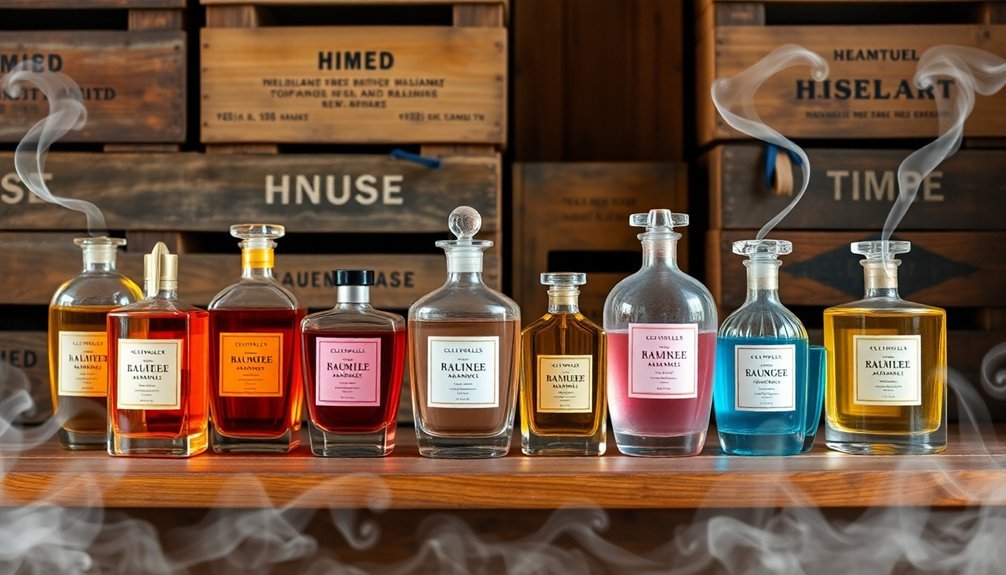
Proper storage of your perfume blends greatly impacts their longevity and quality.
You'll want to keep your creations in cool, dark places away from direct sunlight and humidity. UV light and heat can break down fragrant molecules, altering your carefully crafted scent profile and reducing its potency.
To maximize your blend's lifespan:
- Store bottles in a dedicated drawer or cabinet away from windows and heat sources.
- Always tightly seal bottles after use to minimize oxygen exposure and prevent oxidation.
- Consider refrigeration if you can maintain consistent temperature and humidity levels.
Remember that oxygen begins affecting your perfume the moment you first open it, so proper storage becomes essential from day one.
Avoid keeping perfumes in bathrooms or near heating vents where temperature fluctuations can accelerate aging.
Scaling Your Perfume Formulas
Successful perfume making requires scaling your formulas accurately to guarantee consistent results, whether you're making a small test batch or a large production run.
To scale effectively, you'll need to convert your drop measurements to weights using specific gravity. Multiply each oil's drops by its specific gravity to determine individual weights, then calculate percentages based on the total blend weight. These percentages let you scale to any desired quantity.
When scaling up, it's best to work by weight rather than drops, as this method reduces errors and increases precision. Use a quality scale and start with smaller quantities like 10 grams to perfect your technique.
Remember to maintain proper concentration ratios – for example, a perfume (parfum) needs 20% fragrance oils to 80% alcohol in your final product.
Frequently Asked Questions
Can Pregnant Women Safely Work With Fragrance Notes and Essential Oils?
You shouldn't work with essential oils in your first trimester. After that, you can safely use diluted lavender, chamomile, and ylang ylang oils, but always consult your healthcare provider first.
How Do Weather and Climate Affect the Way Perfume Notes Develop?
You'll notice your perfume's notes react differently in various weather conditions. Heat makes top notes evaporate faster and appear stronger, while cold weather emphasizes base notes and slows down evaporation, affecting overall longevity.
Why Do Some People Experience Headaches From Certain Fragrance Notes?
You may get headaches from certain fragrance notes because they trigger your trigeminal nerve and activate pain receptors in your brain. Your sensitivity to specific scents can cause changes in blood pressure and inflammation.
Are There Specific Notes That Attract or Repel Insects?
You'll attract insects with sweet florals and fruity scents, but you can repel them using herbal notes like rosemary, citrus fragrances, mint, lavender, and eucalyptus in your perfumes and essential oils.
Do Medication Interactions Affect How Perfume Notes Smell on Skin?
Yes, your medications can affect how perfumes smell on your skin. If you're taking medicines that increase sweating or change skin conditions, they'll alter how fragrance notes develop and last on your body.
In Summary
You've learned the fundamentals of perfume creation, from understanding the fragrance pyramid to mastering note ratios and aging techniques. Now you're ready to start crafting your own signature scents. Remember to keep detailed notes of your formulations, test thoroughly, and don't be afraid to adjust your blends. With practice and patience, you'll develop the skills to create beautiful, lasting fragrances that tell your unique olfactory story.





Leave a Reply